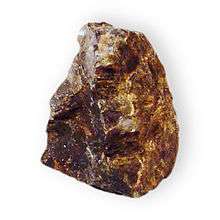Alluaudite
Alluaudite is a relatively common alkaline manganese iron phosphate mineral with formula (Na,Ca)Mn2+(Fe3+,Mn2+,Fe2+,Mg)2(PO4)3. It occurs as metasomatic replacement in granitic pegmatites and within phosphatic nodules in shales.[2]
| Alluaudite | |
|---|---|
 Alluaudite | |
| General | |
| Category | Phosphate minerals |
| Formula (repeating unit) | (Na,Ca)Mn2+(Fe3+,Mn2+,Fe2+,Mg)2(PO4)3 |
| Strunz classification | 8.AC.10 |
| Dana classification | 38.2.3.6 |
| Crystal system | Monoclinic |
| Crystal class | Prismatic (2/m) (same H-M symbol) |
| Space group | C2/c |
| Unit cell | a = 11.03 Å, b = 12.53 Å c = 6.4 Å; β = 97.57°; Z = 4 |
| Identification | |
| Color | Dirty yellow to brownish yellow, grayish green; superficially dull greenish black, brownish black, black, when altered |
| Crystal habit | Platy to radiating fibrous, nodular, granular, massive |
| Twinning | Polysynthetic |
| Cleavage | Distinct/ good on {100} and {010}, good on {110} |
| Mohs scale hardness | 5 - 5.5 |
| Streak | Brownish yellow |
| Diaphaneity | Translucent |
| Specific gravity | 3.4 - 3.5 |
| Optical properties | Biaxial (+) |
| Refractive index | nα = 1.782 nβ = 1.802 nγ = 1.835 |
| Birefringence | δ = 0.053 |
| Pleochroism | X = pale olive-green, straw-yellow to greenish yellow; Z = pale olive-greenish to brownish yellow |
| 2V angle | Measured: 50° to 90°, calculated: 78° |
| References | [1][2][3] |
It was first described in 1848 for an occurrence in Skellefteå, Västerbotten, Sweden. It was named by Alexis Damour after François Alluaud (II) (1778–1866).[1][2]
References
This article is issued from Wikipedia. The text is licensed under Creative Commons - Attribution - Sharealike. Additional terms may apply for the media files.